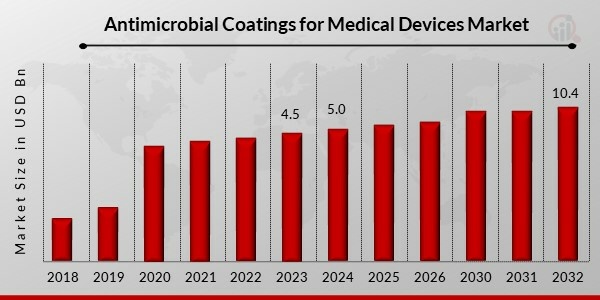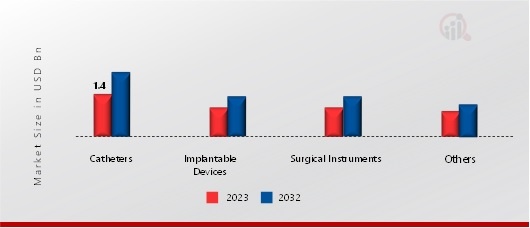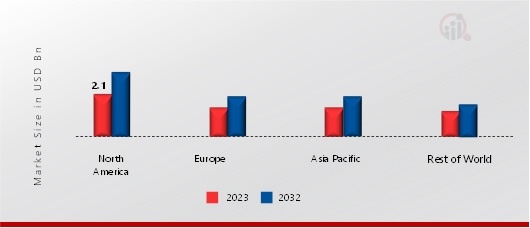Global Antimicrobial Coatings for Medical Devices Market Overview
Antimicrobial Coatings for Medical Devices Market Size was valued at USD 4.5 Billion in 2023. The Antimicrobial Coatings for Medical Devices market industry is projected to grow from USD 5.0 Billion in 2024 to USD 10.4 Billion by 2032, exhibiting a compound annual growth rate (CAGR) of 11.00% during the forecast period (2024 - 2032). Increased prevalence of HAIs, such as surgical site infections and catheter-related bloodstream infections, are the key market drivers enhancing the market growth.

Source: Secondary Research, Primary Research, MRFR Database and Analyst Review
Antimicrobial Coatings for Medical Devices Market Trends
- Growing awareness of infection control is driving the market growth
Market CAGR for antimicrobial coatings for medical devices is being driven by the growing awareness of infection control. Amidst an ever-deepening comprehension of the adverse impacts wrought by healthcare-associated infections (HAIs) upon patient welfare and the fiscal integrity of healthcare systems, there emerges an intensifying focal point on preemptive interventions, notably the employment of antimicrobial coatings. Within the precincts of healthcare establishments, there exists a predilection for the prioritization of strategies geared towards infection mitigation, catalyzing a pervasive integration of coated medical apparatuses to stymie the encroachment of infectious perils. Regulatory bodies, in their custodial capacity, proffer delineations and benchmarks governing the application of antimicrobial coatings, thereby engendering an ambiance conducive to their widespread incorporation. Moreover, an evolving cognizance among patients vis-a-vis the imperatives of infection prophylaxis has precipitated a discernible trend wherein healthcare facilities that espouse the deployment of coated devices are increasingly sought after, emblematic of a conscious effort to curtail the specter of nosocomial afflictions. It is against this backdrop of burgeoning awareness that the impetus for antimicrobial coatings experiences a symbiotic amalgamation of burgeoning demand and the concomitant genesis of innovative modalities.
The exponential surge in the incidence of healthcare-associated infections (HAIs) serves as the fulcrum upon which the market for antimicrobial coatings for medical devices pivots. HAIs, cast in the mold of existential threats to patient well-being, are ensconced in a paradigm where their ramifications reverberate through protracted hospital sojourns and a concomitant uptick in healthcare expenditures. Antimicrobial coatings, as efficacious harbingers of disease prevention, proffer a potent antidote to these perils by staving off bacterial encroachment on medical apparatuses, thereby attenuating the probability of nosocomial infections. Against the backdrop of a global surge in the prevalence of HAIs, healthcare enclaves have calibrated their operational imperatives to encompass a staunch commitment to infection control, epitomized by the wholesale adoption of coated medical contrivances. Regulatory incumbencies, cognizant of their stewardship in safeguarding public health, espouse an ethos underscored by the primacy of infection mitigation, thereby propelling the momentum for antimicrobial coatings. Furthermore, a burgeoning discernment among healthcare practitioners and patients alike vis-a-vis the dividends reaped from the deployment of coated devices in ameliorating infection risks and fortifying patient outcomes precipitates a virtuous cycle, catalyzing an epoch wherein adoption and market proliferation within the ambit of antimicrobial coatings for medical devices are inexorably intertwined.
The uptick in surgical procedures and medical implantations worldwide is a key driver for the antimicrobial coatings for the medical devices market. With the growing volume of surgeries and implantations, there's a heightened risk of healthcare-associated infections (HAIs) related to medical devices. Antimicrobial coatings offer a proactive approach to infection prevention by inhibiting bacterial colonization on the surfaces of medical devices. Surgeons and healthcare providers prioritize the use of coated devices to mitigate infection risks and improve patient outcomes. Moreover, as patients become more aware of the importance of infection control in healthcare settings, there is a growing demand for coated devices to enhance safety. This increasing demand for antimicrobial coatings driven by the rise in surgical procedures and implantations fuels market growth and innovation in the antimicrobial coatings for medical devices segment. For instance, AkzoNobel has collaborated with Bilocate to extend its Interpol brand antimicrobial powder coatings. These coatings are applicable to various internal surfaces, including window frames, ceiling tiles, metal office partitions, metal doors, and elevator doors. This partnership aims to diversify the company's product offerings and enhance its product portfolio.
Antimicrobial Coatings for Medical Devices Market Segment Insights
Antimicrobial Coatings for Medical Devices Type Insights
The Antimicrobial Coatings for Medical Devices Market segmentation, based on type, includes Metallic Coatings (Silver Coatings, Copper Coatings, Others Metallic Coatings) and Non-Metallic Coatings (Polymeric Coatings, Organic Coating). In 2023, the Metallic Coatings segment dominated the market, accounting for 35% of market revenue due to their inherent antimicrobial properties and durability. These coatings, typically made from metals such as silver, copper, and zinc, exhibit broad-spectrum antimicrobial activity against a wide range of pathogens. Moreover, metallic coatings offer long-lasting protection, making them suitable for use on various medical devices, including implants and surgical instruments. The proven efficacy and versatility of metallic coatings make them the preferred choice for healthcare facilities and device manufacturers, capturing the largest market share in the industry.
Non-metallic coatings are experiencing the highest Compound Annual Growth Rate (CAGR) in the antimicrobial coatings for medical devices market due to several factors. These coatings, typically made from polymers or ceramics, offer advantages such as biocompatibility, flexibility, and ease of application. Moreover, non-metallic coatings can be customized to release antimicrobial agents gradually, providing long-lasting protection without the risk of metal ion toxicity. As a result, healthcare providers and device manufacturers are increasingly adopting non-metallic coatings, driving their rapid growth in the market.
Antimicrobial Coatings for Medical Devices Device Type Insights
The Antimicrobial Coatings for Medical Devices Market segmentation, based on Device Type, includes Catheters, Implantable Devices, Surgical Instruments and Others. In 2023, the Catheters category generated the most income due to their widespread use in healthcare settings and the high risk of infection associated with their prolonged use. Antimicrobial coatings on catheters help prevent bacterial colonization on the device's surface, reducing the incidence of catheter-associated infections. Given the significant impact of catheter-related infections on patient outcomes and healthcare costs, healthcare providers prioritize the use of coated catheters, driving their dominance in the market.
Implantable devices are experiencing the highest Compound Annual Growth Rate (CAGR) in the antimicrobial coatings for medical devices market due to several factors. Implantable devices, such as orthopedic implants and cardiovascular stents, are prone to infections that can lead to serious complications. Antimicrobial coatings on these devices help prevent bacterial colonization, reducing the risk of implant-related infections. With the increasing prevalence of implantable medical procedures and the growing awareness of infection control, the demand for coated implantable devices is rapidly rising, driving their high CAGR in the market.
Figure 1: Antimicrobial Coatings for Medical Devices Market, by Device Type, 2023 & 2032 (USD Billion)

Source: Secondary Research, Primary Research, MRFR Database and Analyst Review
Antimicrobial Coatings for Medical Devices Regional Insights
By region, the study provides the market insights into North America, Europe, Asia-Pacific, and the Rest of the World. North America dominates the market for antimicrobial coatings for medical devices due to several factors. The region has a well-established healthcare infrastructure, stringent regulatory standards, and high healthcare expenditure, driving the adoption of advanced infection control measures. Moreover, the presence of key market players and robust research and development activities contribute to market growth. Additionally, growing awareness of healthcare-associated infections and the importance of infection prevention further boost the demand for antimicrobial coatings in North America, solidifying its largest market share.
Further, the major countries studied in the market report are the US, Canada, Germany, France, the UK, Italy, Spain, China, Japan, India, Australia, and South Korea.
Figure 2: Antimicrobial Coatings for Medical Devices Market Share By Region 2023 (USD Billion)

Source: Secondary Research, Primary Research, MRFR Database and Analyst Review
Europe Antimicrobial Coatings for Medical Devices market accounts for the second-largest market share due to a well-developed healthcare infrastructure. Europe holds the second-largest market share in the antimicrobial coatings for medical devices market due to several factors. The region boasts a well-developed healthcare infrastructure with a strong emphasis on infection control measures. Additionally, stringent regulatory standards and a high level of healthcare expenditure drive the adoption of antimicrobial coatings. Furthermore, the presence of leading medical device manufacturers and research institutions fosters innovation in the region, contributing to Europe's significant market share in antimicrobial coatings for medical devices. Further, the German Antimicrobial Coatings for Medical Devices market held the largest market share, and the UK Antimicrobial Coatings for Medical Devices market was the fastest growing market in the European region.
The Asia-Pacific Antimicrobial Coatings for Medical Devices Market is expected to grow at the fastest CAGR from 2024 to 2032. The Asia Pacific region is experiencing the highest Compound Annual Growth Rate (CAGR) in the antimicrobial coatings for medical devices market due to several factors. These include increasing healthcare expenditure, expanding healthcare infrastructure, and growing awareness of infection control measures. Additionally, rising healthcare tourism, coupled with the adoption of advanced medical technologies, drives the demand for antimicrobial coatings in the region. Furthermore, the presence of a large patient population and the emergence of domestic manufacturers contribute to the rapid growth of the market in Asia Pacific. Moreover, China’s Antimicrobial Coatings for Medical Devices market held the largest market share, and the Indian Antimicrobial Coatings for Medical Devices market was the fastest growing market in the Asia-Pacific region.
Antimicrobial Coatings for Medical Devices Key Market Players & Competitive Insights
Leading players in the antimicrobial coatings for medical devices market are focusing on strategic initiatives such as mergers and acquisitions, partnerships, and product innovations to strengthen their market position. They invest in research and market developments to develop advanced coatings with enhanced efficacy and durability. Moreover, companies emphasize regulatory compliance and seek approvals for their coated devices. Furthermore, collaborations with healthcare institutions and research organizations facilitate the development of novel coating technologies, ensuring continued competitiveness in the market.
Manufacturing locally to minimize operational costs is one of the key business tactics used by manufacturers in the global Antimicrobial Coatings for Medical Devices industry to benefit clients and increase the market sector. In recent years, the Antimicrobial Coatings for the Medical Devices industry has offered some of the most significant advantages to Catheters. Major players in the Antimicrobial Coatings for Medical Devices market, including BASF SE, BioInteractions Ltd., Covalon Technologies Ltd., DSM Biomedical, Hydromer Inc., Koninklijke DSM N.V., LyondellBasell Industries Holdings B.V., Medtronic plc, Parx Materials N.V., Specialty Coating Systems, Inc. and Others, are attempting to increase market demand by investing in research and development operations.
BASF SE is a global leader in the development and production of antimicrobial coatings for medical devices. Leveraging its expertise in chemistry and materials science, BASF offers a wide range of innovative coatings designed to inhibit the growth of bacteria and other pathogens on medical surfaces. These coatings are tailored to meet the stringent requirements of healthcare applications, providing long-lasting protection against healthcare-associated infections. BASF's antimicrobial coatings are widely used in medical devices such as catheters, implants, surgical instruments, and wound dressings. The company emphasizes research and development to continuously improve the efficacy and safety of its coatings, ensuring compliance with regulatory standards and meeting the evolving needs of healthcare providers and patients in the antimicrobial coatings for the medical devices market.
BioInteractions Ltd. is a leading innovator in antimicrobial coatings for medical devices. Specializing in advanced biomaterials and surface modification technologies, BioInteractions develops coatings designed to prevent bacterial colonization and biofilm formation on medical surfaces. These coatings are tailored to address specific healthcare applications, including catheters, implants, and wound care products. BioInteractions' coatings are based on proprietary formulations and are characterized by their biocompatibility, durability, and effectiveness against a wide range of pathogens. The company collaborates with healthcare institutions, research organizations, and industry partners to advance the development of antimicrobial coatings and ensure their successful translation into clinical practice. With a commitment to innovation and quality, BioInteractions continues to make significant contributions to the antimicrobial coatings for the medical devices market.
Key Companies in the Antimicrobial Coatings for Medical Devices market include
- Covalon Technologies Ltd.
- Specialty Coating Systems, Inc.
Antimicrobial Coatings for Medical Devices Industry Developments
April 2022: BioInteractions, a UK-based biomaterials technology company, unveiled TridAnt, an innovative coating technology for medical devices. TridAnt represents a significant advancement in infection prevention and pathogen protection, marking a breakthrough in the field.
January 2022: BASF collaborated with membrane manufacturer Permionics Membranes, based in Vadodara, India, to utilize BASF's Ultrason E (PESU: polyether sulfone) in coated fabrics. These fabrics act as particulate and bacterial filters for face masks.
Antimicrobial Coatings for Medical Devices Market Segmentation
Antimicrobial Coatings for Medical Devices Type Outlook
Antimicrobial Coatings for Medical Devices Device Type Outlook
Antimicrobial Coatings for Medical Devices Regional Outlook
| Report Attribute/Metric |
Details |
| Market Size 2023 |
USD 4.5 Billion |
| Market Size 2024 |
USD 5.0 Billion |
| Market Size 2032 |
USD 10.4 Billion |
| Compound Annual Growth Rate (CAGR) |
11.00% (2024-2032) |
| Base Year |
2023 |
| Market Forecast Period |
2024-2032 |
| Historical Data |
2019- 2022 |
| Market Forecast Units |
Value (USD Billion) |
| Report Coverage |
Revenue Forecast, Market Competitive Landscape, Growth Factors, and Trends |
| Segments Covered |
Type, Device Type, and Region |
| Geographies Covered |
North America, Europe, Asia Pacific, and the Rest of the World |
| Countries Covered |
The US, Canada, Germany, France, UK, Italy, Spain, China, Japan, India, Australia, South Korea |
| Key Companies Profiled |
BASF SE, BioInteractions Ltd., Covalon Technologies Ltd., DSM Biomedical, Hydromer Inc., Koninklijke DSM N.V., LyondellBasell Industries Holdings B.V., Medtronic plc, Parx Materials N.V., Specialty Coating Systems, Inc. and Others |
| Key Market Opportunities |
· Development of Novel Coating Technologies and Collaboration with Healthcare Institutions |
| Key Market Dynamics |
· Growing Awareness of Infection Control and Rising Healthcare-Associated Infections |
Frequently Asked Questions (FAQ) :
The Antimicrobial Coatings for Medical Devices Market size was valued at USD 4.5 Billion in 2023.
The global market is projected to grow at a CAGR of 11.00% during the forecast period, 2024-2032.
North America had the largest share in the global market.
The key players in the market are BASF SE, BioInteractions Ltd., Covalon Technologies Ltd., DSM Biomedical, Hydromer Inc., Koninklijke DSM N.V., LyondellBasell Industries Holdings B.V., Medtronic plc, Parx Materials N.V., Specialty Coating Systems, Inc. and Others Company.
The Metallic Coatings category dominated the market in 2023.
The Catheters had the largest share in the global market.

















